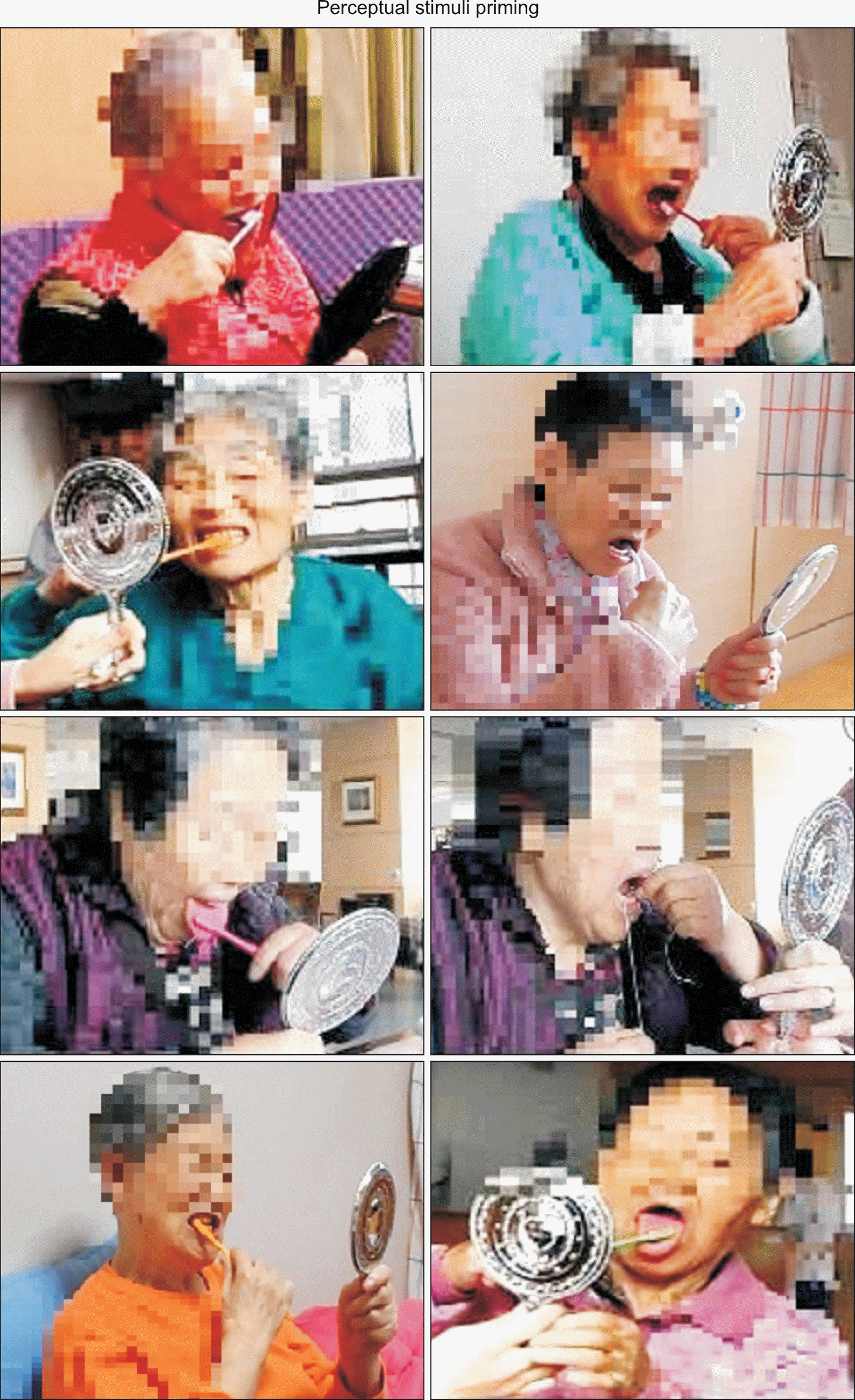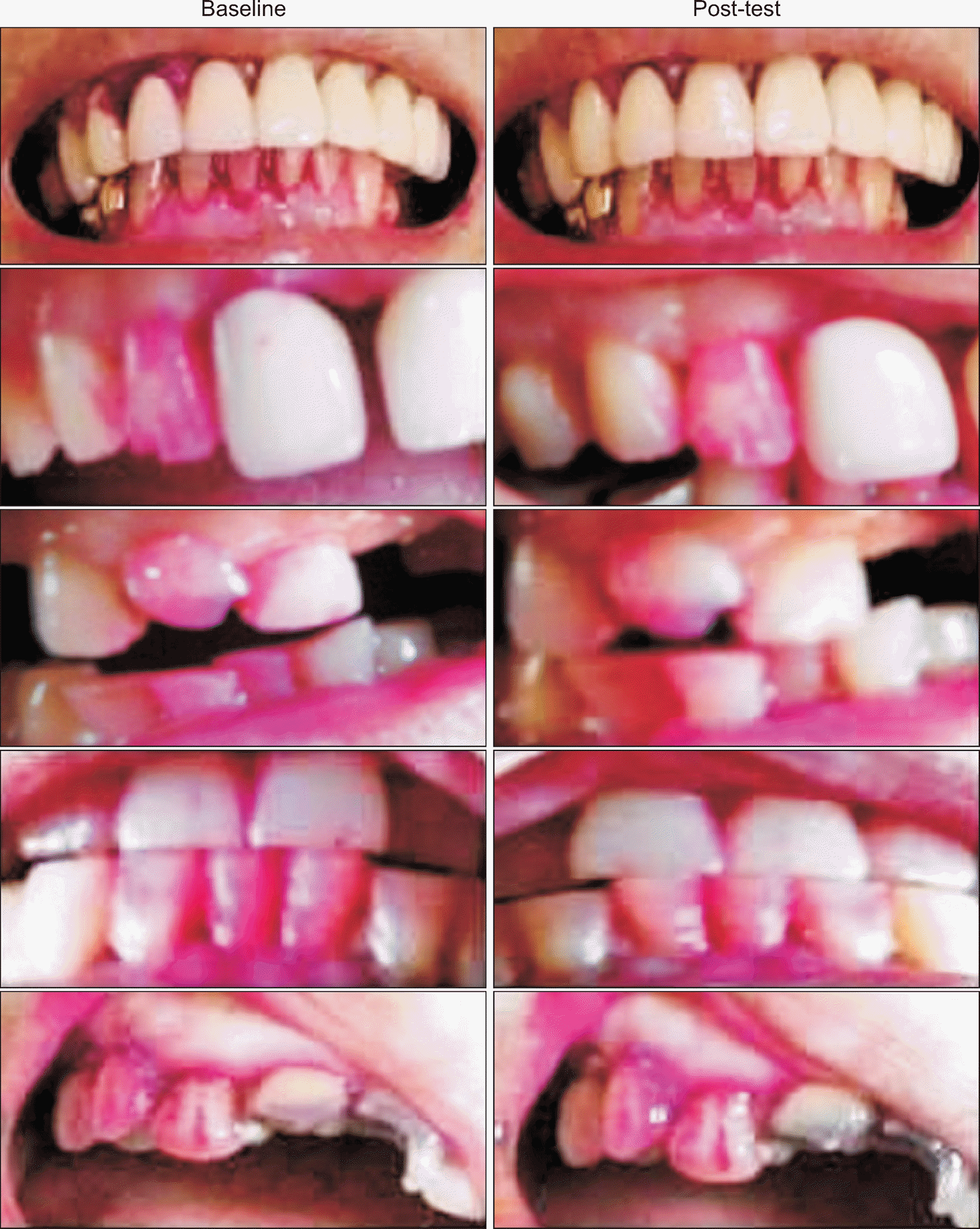Abstract
Objectives
The purpose of this study was to examine the effect of an educational program using priming on oral health, and dental plaque, and gingival bleeding indices in an elderly population with dementia (EWD) residing in nursing homes.
Methods
A pretest and posttest were conducted with a nonequivalent control group. In total, 40 participants from an EWD had the following characteristics: 1) they were aged >65 years, 2) they scored <23 points on the MMSE-DS, 3) they were able to communicate, 4) they were able to hold a toothbrush and brush his or her teeth by themselves, and 5) they had no periodontal treatment for the last 3 months. Through random sampling, participants were assigned into either the experimental (n=20) or control group (n=20). The educational program consisted of twelve 30-minute sessions (twice per week for 6 weeks). The control group was demonstrated the standard tooth-brushing method by the facility during the study period.
Results
There were no significant differences in demographics or main variables at pretest. The experimental group showed significant differences in the subjective oral health condition, as compared to the control group. The experimental group showed an increase in the level of tooth-brushing effort (t=―8.816, P<.001) and higher scores of self-evaluative dental health status (P<.001) as compared to the control group. The experimental group showed a reduced plaque index (t=11.179, P<.001) and gingival bleeding index (t=5.812, P<.001) compared to the control group. Additionally, the experimental group showed significant differences in changes of plaque index and gingival bleeding index between the pretest and posttest.
Conclusions
An interventional program on tooth brushing with priming effectively improved dental health, plaque index, and gingival bleeding index in EWDs residing in nursing homes. Direct care providers should understand the remaining abilities of EWDs and carry out priming when providing care to them.
References
1. Ministry of Health and Welfare. 2012 Nationwide Study on the prevalence of dementia in Korean elders. Seoul: Ministry of Health and Welfare;2012.
2. Jun MJ. Oral Health Status on the aged with dementia in long-term care hospital [Master’s thesis]. Gwangju: Chosun University;2008. [Korean].
3. Cho NI, Park SY, Lee HS, HW Oh. Oral health knowledge and be-havior among nursing home employees in Seoul, Korea. J Korean Acad Oral Health. 2013; 37:16–24.

5. Hong GRS. Effects of multisensory stimulation using familiarity : persons with dementia in long-term care facility in Korea. J Korean Acad Nurs. 2011; 41:528–538.
6. Son G-R, Therrien B, Whall A. Implicit memory and familiarity among elders with dementia. J Nurs Scholarsh. 2002; 34:263–267.

7. Harrison BE, Son G-R, Kim J, Whall A. Preserved Implicit Memory in Dementia: A Potential Model for Care. Am J Alzheimers Dis. 2007; 22:286–293.

8. Kim JO, Kim NC. Effects of 4% Hypertonic Saline Solution Mouthwash on Oral Health of Elders in Long Term Care Facilities. J Korean Acad Nurs. 2014; 44:13–20.

9. Faul F, Erdfelder E, Buchner A, Lang AG. Statistical power analyses using G*Power 3.1: Tests for correlation and regression analyses. Behavior Research Methods. 2009; 41:1149–1160.

10. Yang SB, Moon HS, Han DH, Lee HY, Chung MK. Oral health status and treatment need of institutionalized elderly patients. J Korean Acad Prosthodont. 2008; 46:455–469.

11. Fjeld KG, Mowe M, Eide H, Willumsen T. Effect of electric toothbrush on residents’ oral hygiene: a randomized clinical trial in nursing homes. Eur J Oral Sci. 2014; 122:142–148.

12. Ministry of Health and Welfare. Advanced analysis of Korean national oral health :I. Survey Report. Seoul: Ministry of Health & Welfare;2011. p. 375.
13. Podshadley AG, Haley JV. A method for evaluating oral hygiene performance. Public Health Rep. 1968; 83:610–616.

14. World Health Organization. Oral Health Surveys Basic Methods. 5th Edition. Geneva: WHO;2013. p. 47–49.
15. Sherman E. Reminiscentia: Cherished objects as memorabilia in late life reminiscence. Int J Aging Hum Dev. 1991; 33:89–100.
16. Kolb B, Whishaw IQ. Fundamentals of Human Neuropsychology. 5th ed.NY, US: Worth Publishers;2003. 457:p. 453–454.
17. Biederman Irving, Cooper Eric E. Size invariance in visual object priming. J Exp Psychol Hum Percept Perform. 1992; 18:121–133.

18. Bae KH, Moon HS, Paik DI, Kim JB. Comparison of two tooth brushing instruction methods for adults. J Korean Acad Oral Health. 2000; 24:33–46.
19. Namazi KH, Haynes SR. Sensory stimuli reminiscence for patients with Alzheimer’s disease; Relevance and implications. Clin Geron-tol. 1994; 14:29–46.
20. Park MH, Sung MR, Kim SK, Lee DY. Comparison of Demographic Characteristics, Comorbidity and Health Habits of Older Adults with Mild Cognitive Impairment and Older Adults with Normal Cognitive Function. J Korean Acad Nurs. 2014; 44:351–360.

21. Kim NC, Yoo YS, Hahn SW. The effect of reminiscence with audio-visual stimulation on senile dementia. J Korean Acad Nurs. 2000; 30:98–109.

22. Sánchez A, Millán-Calenti JC, Lorenzo-López L, Maseda A. Multisensory stimulation for people with dementia: a review of the literature. Am J Alzheimers Dis Other Demen. 2013; 28:7–14.
23. Ozdemir L, Akdemir N. Effects of multisensory stimulation on cognition, depression and anxiety levels of mildly-affected Alzheimer’s patients. J Neurol Sci. 2009; 283:211–213.

24. Fujii Y. Two cases of severe dementia showing dramatic improvement after denture placement. Adv Alzheimer Dis. 2016; 5:46–52.

25. Cerutti-Kopplin D, Emami E, Hilgert JB, Hugo FN, Padilha DM. Cognitive status of edentate elders wearing complete denture: Does quality of denture matter? J Dent. 2015; 43:1071–1075.

26. Nakayama Y, Washio M, Mori M. Oral health conditions in patients with Parkinson’s disease. J Epidemiol. 2004; 14:143–150.

27. Alexandra S, Creighton ES, van der Ploeg , O’Connor DW. A literature review of spaced-retrieval interventions: a direct memory intervention for people with dementia. Int Psychogeriatr. 2013; 25:1743–1763.
28. Won YS, Jin KN. The relationship of oral state and health condition among elderly people. J Korean Acad Dental Hygiene Education. 2003; 3:157–166.
29. Cho MM, Lee YH, Kim JB, Lee JH. Promotion of periodontal health through professional toothbrushing and education on the use of the interdental brush in the elderly. J Korean Acad Oral Health. 2013; 37:132–140.

30. Chang KW. Dental plaque control by professional toothbrushing. J Korean Dent Assoc. 2001; 39:443–449.
Fig. 2.
Tooth Brushing using priming in experimental group. Make visually recognize with tooth surface colorant through direct observation via mirror. Promoted attention, interest and sensorimotor skills physical function by themselves (Enhanced cleaning the tongue, using dental floss and Increased frequency of brushing).

Table 1.
Inclusion and exclusion criteria for the study participants
Table 2.
Priming procedure in experimental group
Table 3.
Homogeneity test for general characteristics and main variables at baseline
Table 4.
Effects of toothbrushing program with priming method between baseline and post-test




 PDF
PDF ePub
ePub Citation
Citation Print
Print



 XML Download
XML Download